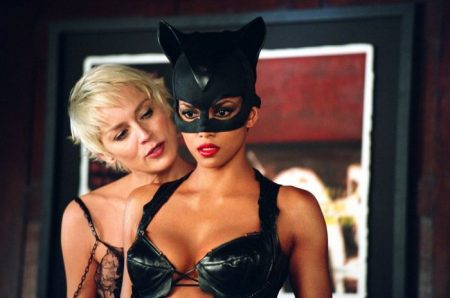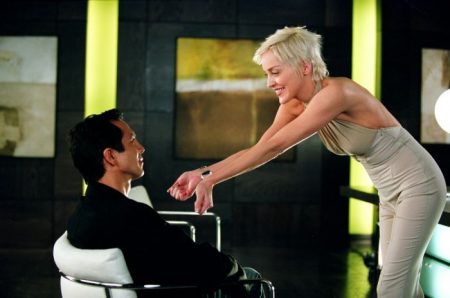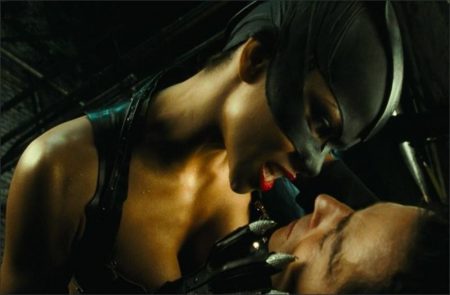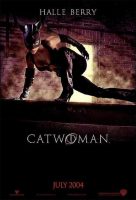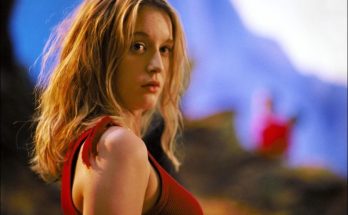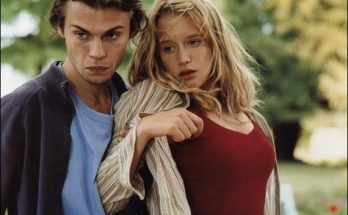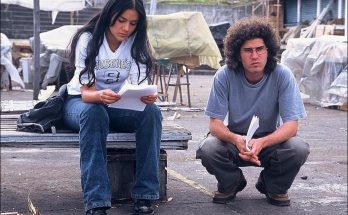Catwoman is the story of shy, sensitive artist Patience Philips, a woman who can’t seem to stop apologizing for her own existence. She works as a graphic designer for Hedare Beauty, a mammoth cosmetics company on the verge of releasing a revolutionary anti-aging product. When Patience inadvertently happens upon a dark secret her employer is hiding, she finds herself in the middle of a corporate conspiracy. What happens next changes Patience forever.
In a mystical twist of fate, she is transformed into a woman with the strength, speed, agility and ultra-keen senses of a cat. With her newfound prowess and feline intuition, Patience becomes Catwoman, a sleek and stealthy creature balancing on the thin line between good and bad. Like any wildcat, she’s dangerous, elusive and untamed. Her adventures are complicated by a burgeoning relationship with Tom Lone, a cop who has fallen for Patience but cannot shake his fascination with the mysterious Catwoman, who appears to be responsible for a string of crime sprees plaguing the city.
Kitten with a Whip
Principal photography on Catwoman began in late September of 2003, but leading lady Halle Berry had begun preparing for the physically demanding role long before the cameras started rolling. “I knew this was going to be a huge undertaking for me,” says Berry, “and I actually started intensive fitness training with Harley Pasternak in June of 2003. I’ve always worked out and been in shape, but I needed to take it to a whole new level to meet the physical challenges of this character and create the kind of body that Catwoman ought to have.”
Berry’s grueling training schedule did not let up once filming began – the actress pushed herself right through the course of principal photography. “My fitness and nutrition regime was constant throughout pre-production and production,” says Berry, “but there were many other skills that I had to work on for the film, like whip training, fight training and movement.”
In the course of her exploits, Catwoman tests the theory that cats have nine lives by getting herself involved in some truly spectacular fights. “Halle did an unbelievable amount of fight work and stunts for this role,” praises Di Novi. “From the beginning she wanted to do as much of it herself as she could.”
Stunt coordinators Steve Davison and Jacob Rupp and fight coordinator Michael Gunther were responsible for teaching Berry choreography for the elaborate fight sequences and making sure she always landed on her feet. Davison calls the actress “one of the fastest learners” with whom he has ever worked. “Halle is just amazing, a total pro,” he says. “Her level of concentration, focus and determination is unlike any I’ve ever seen.”
Anne Fletcher, the film’s choreographer and physicality designer, oversaw Berry’s training in Capoeira (pronounced Cã-po-we-rã), a Brazilian martial art that combines traditional martial arts with dance and gymnastic movements. “It’s one of the most difficult disciplines to learn, but is one of the most beautiful holistic art forms in the world,” says Fletcher.
While Capoeira’s distinctive low-to-the-ground stances and high-in-the-air kicks, jumps and flips might come easy to a Catwoman, they were a challenge for Berry to take on. “Capoeira is probably the hardest thing on the planet to learn to do,” says the actress. “And I had to learn how to do everything in high heels!”
Berry was also charged with learning to properly wield a bullwhip, as the weapon is an inherent part of Catwoman’s lore. It comes in handy when she needs to disarm or dispatch her foes, and also acts as an accessory to her cat suit, whether hanging from her hip or dragging behind her like a long, leather tail.
The task of teaching Berry how to crack a whip like a pro fell to whip master and coach Alex Green. “Halle was one of my best students ever,” says Green. “She was a very quick study. She listened intently and practiced constantly and her hard work paid off. The whip became a true extension of her character.”
Green goes on to explain that the “crack” sound a whip makes is due to the fact that the tail on the whip is actually breaking the sound barrier. When a whip is cracked properly it travels at 950 miles per hour – 1,400 feet per second. “The speed and force of a whip crack is something you must be very respectful of,” says Green. “Halle recognized that immediately. She was never fearful, but always respectful.”
Green began Berry’s whip training with what he considers to be the easiest crack to learn, the vertical, or ‘circus’ crack. She then worked her way up to the forward crack, the horizontal crack, the reverse horizontal and some “other surprises” that Green does not want to give away.
“Of all my training, learning to crack the whip was the most fun,” says Berry, who was gifted by Green with a custom bullwhip all her own. “The whip is probably the most elusive tool you can play with, but it’s also the most sexy and the most fun. Once you get that first good crack, there’s nothing else like it!”
On top of preparing for her fight scenes and undergoing special training to become whipproficient, Berry also took on extensive dance and movement training to perfect her feline style.
“A lot of the action that Halle does in the movie is based on actual cat movement,” comments Di Novi. “When you see cats leaping from eight stories or doing figure eights in mid-air, it’s almost supernatural, and re-creating that with a female human body was fantastic.”
Catting Around
In addition to informing her fighting technique, it was important that Berry’s entire physical performance as Catwoman be imbued with nuances of cat movement and behavior that would believably communicate her slinky feline persona. Although some CGI was used to generate movements that the human body simply can’t replicate, choreographer Anne Fletcher was brought in to develop Catwoman’s signature style and teach Berry.
“Pitof wanted Catwoman’s physicality to be as real as possible,” Fletcher relates. “He said that she’s a woman first and a cat second, but he wanted to see how cat-like a human body could become.”
“Anne should put ‘cat specialist’ on her resume,” says Berry. “She really helped me define how cats behave and discover how Catwoman would move and what her thought processes might be. I also watched hours of videotape, anything I could get my hands on with cats and lions.”
Additionally, Berry spent a great deal of time with animal coordinator Boone Narr, lead trainer Mark Harden, their training staff and the 43 cats used in the making of the film. This gave the actress and the cats time to get used to each other and also provided Berry with 43 cat behavior experts to study with.
According to Narr, one of the biggest hurdles in his work on Catwoman was convincing the filmmakers to use more live cats in the film rather than computer generated cats. “People tend to believe that domestic cats are un-trainable,” says Narr. “The truth is they are very trainable. Once we showed Pitof and the producers some of the things we could teach the cats to do, they agreed to let us work with them more extensively. The result is that 99% of the cats you see in the movie are real, not computer generated, which made our job very fun and very rewarding.”
Most of the cats cast in the film came from animal shelters throughout California. “Midnight,” the cat who breathes new life into Patience, is a rare Egyptian Mau. “The Maus were our little discoveries,” says Narr, “and training them raised the bar for us. In my 33 years in the business, I do not think I have ever seen a cat that is so sharp. They are strikingly beautiful and the filmmakers just fell in love with them.”
Cairo, Nile and Scarab, the three lead Egyptian Mau cats who together portray the omnipotent Midnight, hail from New Jersey and were cast after an extensive search for the relatively rare breed. Although they are all breeders’ show cats, none of the three had any prior training for film work. Each of the feline actors had their own personal specialty. Cairo was the principal character cat, and handled most of the work with Berry. Nile’s mellow personality made him perfect for quiet sitting scenes, and Scarab, who loves to run, jump and chase, became the ‘stunt cat,’ stepping in whenever action was involved.
The trainers spent close to four months preparing the three lead cats for their work. Teaching them to perform all the action called for in the script demanded a blend of ingenuity and patience. Narr recounts the preparation that went into the opening scene of the film, in which a cat chases a mouse through winding city streets. “Obviously we couldn’t let the cat chase a real mouse,” says Narr. “Instead, we taught him to chase a red laser light and filmed the cat running through the city. In post-production, a computer-generated mouse replaced the laser light.” Narr’s company, Animals for Hollywood, pioneered the use of laser light training. “We find most animals respond well to the laser light. It allows us to get shots we would never have been able to accomplish in the past.”
Besides being physically striking and very intelligent, the ancient Mau breed originated in Egypt, a fact that played right into the hands of the script; the movie’s mythology of Catwoman’s origins centers around the Egyptian goddess Bast, the sacred protector and avenger of women, often depicted with the body of a woman and the head of a cat. Patience comes to earn about Bast from the enigmatic Ophelia Powers, played by Frances Conroy.
Conroy was surrounded by cats at all times during production, and as a cat lover, the actress was impressed by the thoughtful work of Narr and company. “They’re beautifully cared for cats,” she compliments. “I’ve had cats all my life, so this was all very familiar territory to me, but it really is remarkable what they are able do, whether they are just being still – which isn’t the easiest thing in the world for a cat to do – or performing all the tasks that they were trained to accomplish.”
One of the film’s cats, named Fig Newton, lived with Berry for much of the production and served as her in-house cat movement model. At the end of filming, the actress adopted Playdough, another member of the feline cast. “Unlike Frances, I was not a cat person prior to making this film,” says Berry. “They always seemed too aloof, not needy like dogs, but I love my cat now. Seeing the way Boone and Mark and all the trainers worked with the cats was really one of the most fascinating aspects of making this movie.”
A Suitable Fit
Producer Di Novi found the creation of a brand new Catwoman cat suit to be an exciting element of the production. “We all wanted to create something that was a little more urban, a little more contemporary,” says Di Novi. “It had to be tailor-made to reflect Halle’s characterization, so she had a big hand in the design of the suit.”
Together with Academy Award-winning costume designer Angus Strathie, Berry, director Pitof and the producers collaborated on the sexy suit. “I’m very proud of the costume design,” says director Pitof. “Here again, it has elements of previous cat suits but it is so unique to Halle, to her shape and beauty. It shows a lot of skin but also has a warrior-like quality to it. When she wears it she looks like somebody who’s ready for a fight.”
“What I liked best about it is how freeing it was,” recalls Berry. “You can see her spine, her ribs and the lean, sinewy musculature of the cat. The other great thing about the cat suit is that, within the story, it’s very realistic as to how Patience comes up with the outfit. It’s not like she just pulls it out of a secret closet in her apartment. She’s an artist and she uses her artistic sensibilities to put the whole disguise together.”
Costume designer Angus Strathie explains how his inspiration was grounded in the character’s own metamorphosis. “We wanted a very reality-based wardrobe to show the progression from demure, repressed Patience to the sensual awakening of a sexy warrior goddess.”
For Strathie and his team, the design, creation and construction of the cat suits was a labor-intensive and time-consuming process. “There were so many elements to take into consideration because the cat suit is such a distinctive, almost historical costume. We did want to pay some homage to the other Catwomen and I think we achieved a wonderful blend of the past and the not-too-distant future.
“One big design challenge was deciding what material we should use,” continues Strathie. “The costumes for the earlier television and film Catwomen were cutting-edge for their time – Julie Newmar and Eartha Kitt wore lurex and Michelle Pfeiffer wore latex. Now, Halle is wearing a combination of leather and a brand new silicone fabric we created just for this costume.”
Perhaps one of the most striking elements of the cat suit are its ten “diamond”-tipped claws. Almost 800 individual crystals were used to create the pavé diamond look on sterling silver settings.
Strathie’s time was also spent combing racks for designer clothes in which to wrap Sharon Stone for her role as the fanatically fashionable Laurel Hedare. “Sharon is as chic and stylish as her character is,” says Strathie, “so it was a lot of fun shopping with her to find just the right clothes for her alter-ego. Luckily, Sharon is very knowledgeable about fashion, she knows what she likes to wear and she’s incredibly creative. She loves to mix and match and brought a lot of her own fashion sense to the film, which serviced the character very effectively.”
“I wanted Laurel to give the impression that she can’t be too rich or too thin,” says Stone, “so there’s an almost surreal sort of void feel to my look. I’ve got some great Hermes bags, Jimmy Choo shoes and Fendi gave us some beautiful furs. Laurel has no conscience about anything, so she’s wild about fur. She’s just a big design slave and it was fabulous fun playing dress up with her!”
In a tribute to Catwoman’s sexy style, Fifth Avenue fashion mecca Henri Bendel, one of the country’s most distinguished fashion institutions, is currently featuring an exclusive line of Catwoman merchandise. The store carries a special selection of apparel, accessories, and other products inspired by the film. The legendary Henri Bendel windows have also been styled in a Catwoman theme.
Catwalks and Cat Scans
Creating a world in which Catwoman and Patience Philips could believably co-exist necessitated an artful blend of the fantastical and the practical. “We didn’t want Catwoman to look like any other action film,” stresses Di Novi. “We wanted to ground the film’s world in reality, while stylizing it just enough that it is a bit hyper-real. It also takes place in the world of cosmetics and art and advertising, so there is a level of sophistication that is really glossy and alluring.”
Much of the challenge of creating the brave new visual world of Catwoman fell on the shoulders of production designer Bill Brzeski, visual effects designer/supervisor Ed Jones and their respective teams of designers, decorators and technicians. Both men credit director Pitof and his extensive visual effects background for the freedom they felt in executing their particular design tasks.
Brzeski says that his work on the film was “great fun,” because from a design standpoint, so many of the sets are radically diverse. “We’ve got everything from Patience’s bohemian apartment, to Ophelia’s mystical shrine-like house, to the ‘design for design’s sake’ cosmetics company headquarters,” says Brzeski. Among his other personal favorites are the cosmetics factory and the massive photographic layout of Sharon Stone as Laurel Hedare that decorates the company’s headquarters, which was created during a two-day photo shoot with renowned photographer Mondino.
Once it was assembled, the immense exhibition made quite an impression on Stone. “When I first walked into the gallery in the boardroom and there were twelve-by-twelve foot photos of me everywhere, it was very intimidating and strange. And then Pitof had the idea to have the pictures grow as Laurel’s egomania gets more out of control, so by the end of the movie the pictures are 40 foot tall and there’s sixty of them! I finally had to surrender to it, but it was really just too much.”
In addition to rotoscope, motion-control, animation and motion capture technology, visual effects designer Ed Jones also utilized the process known as ‘universal capture,’ which was invented by ESC Entertainment for use in The Matrix Reloaded and The Matrix Revolutions.
All told, over 600 visual effect shots were created for the film. “Utilizing current digital technology, we created 100% synthetic versions of Halle Berry as Catwoman and Midnight the cat for scenes that could not be filmed practically,” says Jones.
“To create the digital replications of Halle, high resolution digital scans, photo references and plaster life-casts were taken. Additionally, we scanned her entire wardrobe to capture all the textural qualities so that we could replicate every detail. We filmed Halle doing a range of emotional facial performances that were then mapped on to her digital double to give us a synthetic character with real facial performances. The goal was to blend the digital characters with the real performers to create seamless, realistic and believable action. Several of the sequences also involved the same digital tools to create the environments virtually. Consequently, there are shots in the movie that are 100% digital.”
The Cat’s Pajamas
In honor of the last day of principal photography on February 20, 2004, many of the Catwoman crew went to work in their pajamas. The reason was two-fold: firstly, to prepare for a well-deserved and perhaps lengthy catnap; and secondly, to celebrate what was for them, the cast and the filmmakers, a truly extraordinary experience.
When asked what she misses most about playing Catwoman, Berry says, “The sense of power, her ‘don’t mess with me’ attitude. Playing her I was allowed to live in this altered state for a little while where I could just soar. That feeling of freedom is something that really benefited my own life and it’s something that I can carry with me forever. It’s in me now and I don’t think it will ever go away.”
Catwoman (2004)
Directed by: Jean-Christophe ‘Pitof’ Comar
Starring: Halle Berry, Benjamin Bratt, Sharon Stone, Lambert Wilson, Ellen Pompeo, Alex Borstein, Frances Conroy, Kim Smith, Manny Petruzzelli, Chase Nelson-Murray
Screenplay by: John Brancato, Mike Ferris
Production Design by: Bill Brzeski
Cinematography by: Thierry Arbogast
Film Editing by: Sylvie Landra
Costume Design by: Angus Strathie
Art Direction by: Shepherd Frankel, Don Macaulay, Frank Varela
Set Decoration by: Carol Lavallee: Lisa K. Sessions
Music by: Klaus Badelt
MPAA Rating: PG-13 for action violence and some sensuality.
Distributed by: Warner Bros. Pictures
Release Date: July 23, 2004
Views: 663
